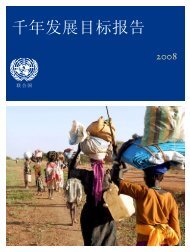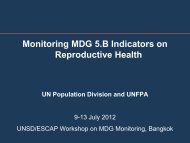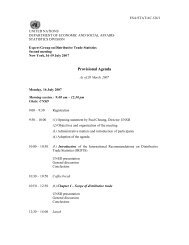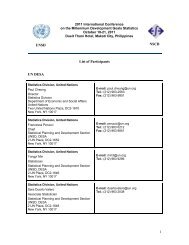- Page 3: DEMOGRAPHIC YEARBOOK ANNUAIRE DEMOG
- Page 6 and 7: UNITED NATIONS PUBLICATION SALES NO
- Page 8 and 9: TABLE OF CONTENTS (continued) -TABL
- Page 13 and 14: CHAPTER I. RECENT MORTALITY TRENDS
- Page 15 and 16: tions in the intermediate ages (not
- Page 17 and 18: erly recorded but the registration
- Page 19 and 20: ates of less than 1 per 1,000 in 14
- Page 21 and 22: TABLE I Number of deaths from selec
- Page 23 and 24: These regulations are as binding on
- Page 25 and 26: 1 1 1 1 1 Agreement between individ
- Page 27 and 28: equal to the development of the Int
- Page 29 and 30: Accuracy of diagnosis Some countrie
- Page 31 and 32: • CHAPTER III. TECHNICAL NOTES ON
- Page 33 and 34: those for Europe and Oceania may be
- Page 35 and 36: certain to indicate improvement in
- Page 37 and 38: B. 26 weeks (or 6 months, as indica
- Page 39 and 40: mortality rates for 119 areas for t
- Page 41 and 42: tions than do conventional central
- Page 43: are given in footnotes. Information
- Page 47 and 48: CHAPITRE I. TENDANCES RECENTES DE M
- Page 49 and 50: elatifs aux enfants au-dessous de c
- Page 51 and 52: des pays qui ont accuse une baisse
- Page 53 and 54: 21 taux de mortalite pour les ages
- Page 55 and 56: II. Taux de 700 a 799 par 700.000 h
- Page 57 and 58: CHAPITRE II. DEVELOPPEMENT DES STAT
- Page 59 and 60: Nomenclature est composee de 18 gro
- Page 61 and 62:
tage en Turquie provient des pratiq
- Page 63 and 64:
Modele International de Certifkat M
- Page 65 and 66:
l'ensemble des deces d'une populati
- Page 67 and 68:
CHAPITRE III. CONSIDERATIONS SUR LE
- Page 69 and 70:
precedent, mais aussi parce qu'une
- Page 71 and 72:
Asie (suite); Japon (mariages, divo
- Page 73 and 74:
Le tableau 8 presente, pour 33 pays
- Page 75 and 76:
STATISTIQUES DE LA MORTALITE Les ta
- Page 77 and 78:
Comme pour les tableaux precedents,
- Page 79 and 80:
cette fonction est communement indi
- Page 81 and 82:
les migrations, Ie Bureau Internati
- Page 83:
MAPS CARTES
- Page 86 and 87:
Prepared for the Demographic Yearbo
- Page 88 and 89:
Prepared for the Demographic Yearbo
- Page 90 and 91:
Prepared for the Prepare pour l'Ann
- Page 92 and 93:
NOTE ON GEOGRAPHIC AREAS Insofar as
- Page 95 and 96:
POPULATION 1. Population, area and
- Page 97 and 98:
POPULATION 1. Population, area and
- Page 99 and 100:
POPULATION 1. Population, area and
- Page 101 and 102:
POPULATION 1. Population, area and
- Page 103 and 104:
POPULATION 1. Population, area and
- Page 105 and 106:
POPULATION 1. Population, area and
- Page 107 and 108:
POPULATION 1. Population, area and
- Page 109 and 110:
2. Enumerated population
- Page 111 and 112:
2. Enumerated population (continued
- Page 113 and 114:
2. Enumerated population (continued
- Page 115 and 116:
2. Enumerated population (continued
- Page 117 and 118:
2. Enumerated population (continued
- Page 119 and 120:
2. Enumerated population (continued
- Page 121 and 122:
2. Enumerated population (continued
- Page 124 and 125:
POPULATION 3. Estimates of total po
- Page 126 and 127:
POPULATION 3. Estimates of total po
- Page 128 and 129:
POPULATION 3. Estimates of total po
- Page 130 and 131:
POPULATION 3. Estimates of total po
- Page 132 and 133:
POPULATION 4. Population by age and
- Page 134 and 135:
~-- POPULATION 4. Population by age
- Page 136 and 137:
POPULATION 4. Population by age and
- Page 138 and 139:
POPULATION 4. Population by age and
- Page 140 and 141:
POPULATION 4. Population by age and
- Page 142 and 143:
POPULATION 4. Population by age and
- Page 144 and 145:
----_._~-- __n POPULATION 4. Popula
- Page 146 and 147:
POPULATION 4. Population by age and
- Page 148 and 149:
---_._-~---~---------_._._-------_.
- Page 150 and 151:
_._-~--- ----------_. BIRTHS 5. Cru
- Page 152 and 153:
BIRTHS 6. Number of live births [Fo
- Page 154 and 155:
j BIRTHS 6. Number of live births
- Page 156 and 157:
BIRTHS 6. Number of live births
- Page 158 and 159:
BIRTHS 6. Number of live births (co
- Page 160 and 161:
BIRTHS 7. Crude birth rates 1930 -1
- Page 162 and 163:
1 1 BIRTHS 7. Crude birth rates
- Page 164 and 165:
BIRTHS 7. Crude birth rates
- Page 166 and 167:
1 BIRTHS 7. Crude birth rates
- Page 168 and 169:
BIRTHS 8. Birth rates specific for
- Page 170 and 171:
BIRTHS 8. Birth rates specific for
- Page 172 and 173:
BIRTHS 8. Birth rates specific for
- Page 174 and 175:
BIRTHS 9. Birth rates by order of b
- Page 176 and 177:
BIRTHS 9. Birth rates by order of b
- Page 178:
BIRTHS 9. Birth rates by order of b
- Page 181 and 182:
MORT-NES 10. Nombre de mort-nes 193
- Page 183 and 184:
MORT-NES 10. Nombre de mort-nes (su
- Page 185 and 186:
MORT-NES 10. Nombre de mort-nes {su
- Page 187 and 188:
MORT-NES 11. Rapport des mort-m!s a
- Page 189 and 190:
MORT-NES 11. Rapport des mort-nes a
- Page 191 and 192:
MORT-NES 11. Rapport des mort-nes a
- Page 193 and 194:
DECES 12. Crude death rates 1905 -
- Page 195 and 196:
DECES 13. Nombre de deces 1935 -195
- Page 197 and 198:
13. Nombre de deces (suite) [Pour u
- Page 199 and 200:
DECES 13. Nombre de deces (suite) [
- Page 201 and 202:
DECES 13. Nombre de deces (suite) [
- Page 203 and 204:
DECES 14. Taux bruts de mortalite 1
- Page 205 and 206:
DECES 14. Taux bruts de mortalite (
- Page 207 and 208:
DECES 14. Taux bruts de mortalite (
- Page 209 and 210:
DECES 14. Taux bruts de mortalite (
- Page 211 and 212:
15. Number of deaths by month of oc
- Page 213 and 214:
DECES 15. Number of deaths by month
- Page 215 and 216:
DECES 15. Number of deaths by month
- Page 217 and 218:
DECES 15. Number of deaths by month
- Page 219 and 220:
1 DECES 15. Number of deaths by mon
- Page 221 and 222:
DECES 16. Deces par age et par sexe
- Page 223 and 224:
DECES 16. Deces par age et par sexe
- Page 225 and 226:
DECES 16. Deces par age et par sexe
- Page 227 and 228:
16. Deces par age el' par sexe (sui
- Page 229 and 230:
DECES 16. Oeces par age et par sexe
- Page 231 and 232:
DECES 16. Deces par age et par sexe
- Page 233 and 234:
DECES 16. Deces par age et par sexe
- Page 235 and 236:
DECES 16. Deces par age et par sexe
- Page 237 and 238:
DECES 16. Deces par age et par sexe
- Page 239 and 240:
DECES 16. Deces par age et par sexe
- Page 241 and 242:
DECES 16. Deces par age et par sexe
- Page 243 and 244:
DECES 16. Deces par age et par sexe
- Page 245 and 246:
DECES 16. Deces par age et par sexe
- Page 247 and 248:
16. Deces par age et par sexe {suit
- Page 249 and 250:
DECES 16. Deces par age et par sexe
- Page 251 and 252:
DECES 16. Deces par age et par sexe
- Page 253 and 254:
DECES 16. Deces par age et par sexe
- Page 255 and 256:
DECES 16. Deces par age et par sexe
- Page 257 and 258:
DECES 16. Deces par age et par sexe
- Page 259 and 260:
OECES 16. Deces par age et par sexe
- Page 261 and 262:
DECES 16. Deces par age et par sexe
- Page 263 and 264:
DECES 16. Deces par age et par sexe
- Page 265 and 266:
DECES 16. Deces par age et par sexe
- Page 267 and 268:
DECES 16. Deces par age et par sexe
- Page 269 and 270:
DECES 16. Deces par age et par sexe
- Page 271 and 272:
DECES 16. Deces par age et par sexe
- Page 273 and 274:
DECES 16. Deces par age et par sexe
- Page 275 and 276:
DECES 16. Deces par age et par sexe
- Page 277 and 278:
16. Deces par age et par sexe (suit
- Page 279 and 280:
OECES 16. Deces par age et par sexe
- Page 281 and 282:
DECES 16. Deces par age et par sexe
- Page 283 and 284:
DECES 16.' Deces par age et par sex
- Page 285 and 286:
DECES 16. Deces par age et par sexe
- Page 287 and 288:
OECES 16. Deces par age et par sexe
- Page 289 and 290:
• DECES 16. Deces par age et par
- Page 291 and 292:
OECES 16. Oeces par age et par sexe
- Page 293 and 294:
~ 17. Taux de mortalite selon I'age
- Page 295 and 296:
~,_. DECES 17. Taux de mortalite se
- Page 297 and 298:
DECES 17. Taux de mortalite selon I
- Page 299 and 300:
DECES 17. Taux de martalite selon I
- Page 301 and 302:
OECES 17. Taux de mortalite selon I
- Page 303 and 304:
DECES 17. Taux de mortalite selon I
- Page 305 and 306:
DECES 17. Taux de mortalite selon I
- Page 307 and 308:
DECES 17. Tauxde mortalite selon I'
- Page 309 and 310:
DECES 17. Taux de mortalite selon I
- Page 311 and 312:
DECES 17. Taux de mortalite selon I
- Page 313 and 314:
-~-- ~- -----~~ DECES 17. Taux de m
- Page 315 and 316:
DECES 17. Taux de mortalite selon I
- Page 317 and 318:
1 OECES 17. Taux de mortalite selon
- Page 319 and 320:
DECES 17. Taux de mortalite selon I
- Page 321 and 322:
-~---- DECES 17. Taux de mortalite
- Page 323 and 324:
DECES 17. Taux de mortalite selon I
- Page 325 and 326:
DECES 18. Mortalite infantile 1935
- Page 327 and 328:
DECES 18. Mortalite infantile (suit
- Page 329 and 330:
DECES 18. Mortalite infantile (suit
- Page 331 and 332:
OECES 18. Mortalite infantile (suit
- Page 333 and 334:
OECES 19. Taux de mortalite infanti
- Page 335 and 336:
DECES 19. Taux de mortalite infanti
- Page 337 and 338:
DECES 19. Taux de mortalite infanti
- Page 339 and 340:
DECES 19. Taux de mortalite infanti
- Page 341 and 342:
DECES 20. Deaths under one year of
- Page 343 and 344:
DECES 20. Deaths under one year of
- Page 345 and 346:
DECES 20. Deaths under one year of
- Page 347 and 348:
DECES 20. Deaths under one year of
- Page 349 and 350:
DECES 20. Deaths under one year of
- Page 351 and 352:
DECES 20. Deaths under one year of
- Page 353 and 354:
DECES 20. Deaths under one year of
- Page 355 and 356:
DECES 20. Deaths under one year of
- Page 357 and 358:
DECES 20. Deaths under one year of
- Page 359 and 360:
~-~~~~- DECES 20. Deaths under one
- Page 361 and 362:
DECES 20. Deaths under one year of
- Page 363 and 364:
DECES 20. Deaths under one year of
- Page 366 and 367:
DEATHS 21. Infant mortality rates b
- Page 368 and 369:
DEATHS 21. Infant mortality rates b
- Page 370 and 371:
DEATHS 21. Infant mortality rates b
- Page 372 and 373:
DEATHS 21. Infant mortality rates b
- Page 374 and 375:
DEATHS 21. Infant mortality rates b
- Page 376 and 377:
DEATHS 21. Infant mortality rates b
- Page 378 and 379:
DEATHS 21. Infant mortality rates b
- Page 380 and 381:
DEATHS 21. Infant mortality rates b
- Page 382 and 383:
DEATHS 21. Infant mortality rates b
- Page 384 and 385:
DEATHS 21. Infant mortality rates b
- Page 386 and 387:
'DEATHS 21. Infant mortality rates
- Page 388 and 389:
DEATHS 21. Infant mortality rates b
- Page 390 and 391:
DEATHS 21. Infant mortality rates b
- Page 392 and 393:
DEATHS 21. Infant mortality rates b
- Page 394 and 395:
DEATHS 21. Infant mortality rates b
- Page 396 and 397:
DEATHS 21. Infant mortality rates b
- Page 398 and 399:
DEATHS 21. Infant mortality rates b
- Page 400 and 401:
DEATHS 22. Deaths by cause, numbers
- Page 402 and 403:
DEATHS 22. Deaths by cause, numbers
- Page 404 and 405:
DEATHS 22. Deaths by cause, numbers
- Page 406 and 407:
DEATHS 22. Deaths by cause, numbers
- Page 408 and 409:
1 1 DEATHS 22. Deaths by cause, num
- Page 410 and 411:
DEATHS 22. Deaths by cause, numbers
- Page 412 and 413:
DEATHS 22. Deaths by cause, numbers
- Page 414 and 415:
DEATHS 22. Deaths by cause, numbers
- Page 416 and 417:
' 1 1 1 1 1' 1 DEATHS 22. Deaths by
- Page 418 and 419:
DEATHS 22. Deaths by cause, numbers
- Page 420 and 421:
DEATHS 22. Deaths by cause, numbers
- Page 422 and 423:
DEATHS 22. Deaths by cause, numbers
- Page 424 and 425:
DEATHS 23. Deaths by cause, age and
- Page 426 and 427:
DEATHS 23. Deaths by cause, age and
- Page 428 and 429:
DEATHS 23. Deaths by cause, age and
- Page 430 and 431:
DEATHS 23. Deaths by cause, age and
- Page 432 and 433:
DEATHS 23. Deaths by cause, age and
- Page 434 and 435:
DEATHS 23. Deaths by cause, age and
- Page 436 and 437:
DEATHS 23. Deaths by cause, age and
- Page 438 and 439:
OEATHS 23. Deaths by cause, age and
- Page 440 and 441:
DEATHS 23. Deaths by cause, age and
- Page 442 and 443:
DEATHS 23. Deaths by cause, age and
- Page 444 and 445:
DEATHS 23. Deaths by cause, age and
- Page 446 and 447:
DEATHS 23. Deaths by cause, age and
- Page 448 and 449:
DEATHS 23. Deaths by cause, age and
- Page 450 and 451:
DEATHS 23. Deaths by cause, age and
- Page 452 and 453:
DEATHS 23. Deaths by cause, age and
- Page 454 and 455:
DEATHS 23. Deaths by cause, age and
- Page 456 and 457:
1 DEATHS 23. Deaths by cause, age a
- Page 458 and 459:
1 1 DEATHS 23. Deaths by cause, age
- Page 460 and 461:
DEATHS 23. Deaths by cause, age and
- Page 462 and 463:
DEATHS 23. Deaths by cause, age and
- Page 464 and 465:
DEATHS 23. Deaths by cause, age and
- Page 466 and 467:
---~ DEATHS 23. Deaths by cause, ag
- Page 468 and 469:
DEATHS 23. Deaths by cause, age and
- Page 470 and 471:
DEATHS 23. Deaths by cause, age and
- Page 472 and 473:
DEATHS 23. Deaths by cause, age and
- Page 474 and 475:
_~_-. DEATHS 23. Deaths by cause, a
- Page 476 and 477:
DEATHS 23. Deaths by cause, age and
- Page 478 and 479:
--- MARRIAGES 24. Number of marriag
- Page 480 and 481:
--_._---,._-_._--~.-,-~ I MARRIAGES
- Page 482 and 483:
MARRIAGES 24. Number of marriages
- Page 484 and 485:
MARRIAGES 24. Number of marriages (
- Page 486 and 487:
MARRIAGES Country Code 1 1930 AFRIC
- Page 488 and 489:
MARRIAGES 25. Crude marriage rates
- Page 490 and 491:
MARRIAGES 25. Crude marriage rates
- Page 492 and 493:
MARRIAGES 25. Crude marriage rates
- Page 494 and 495:
DIVORCES 26. Number of divorces 193
- Page 496 and 497:
-----------------------------------
- Page 498 and 499:
DIVORCES 26. Number of divorces (co
- Page 500 and 501:
UFE TABLES 27. Life table mortality
- Page 502 and 503:
LIFE TABLES 27. life table mortalit
- Page 504 and 505:
,~ LIFE TABLES 27. Life table morta
- Page 506 and 507:
LIFE TABLES 27. Life table mortalit
- Page 508 and 509:
LIFE TABLES 27. life table mortalit
- Page 510 and 511:
LIFE TABLES 27. Life table mortalit
- Page 512 and 513:
LIFE TABLES 27. Life table mortalit
- Page 514 and 515:
LIFE TABLES 27. life table mortalit
- Page 516 and 517:
LIFE TABLES 28. Survivors at specif
- Page 518 and 519:
2 89 LIFE TABLES 28. Survivors
- Page 520 and 521:
LIFE TABLES 28. Survivors (continue
- Page 522 and 523:
LIFE TABLES 28. Survivors (continue
- Page 524 and 525:
LIFE TABLES 28. Survivors (continue
- Page 526 and 527:
90 1__ LIFE TABLES 28. Survivors (c
- Page 528 and 529:
II iiiii; 806141 LIFE TABLES 28. Su
- Page 530 and 531:
" LIFE TABLES 29. Expectation of li
- Page 532 and 533:
. 1 LIFE TABLES 29. Expectation of
- Page 534 and 535:
. LIFE TABLES 29. Expectation of li
- Page 536 and 537:
--~-~ ---- LIFE TABLES 29. Expectat
- Page 538 and 539:
1 1 LIFE TABLES 29. Expectation of
- Page 540 and 541:
LIFE TABLES 29. Expectation of life
- Page 542 and 543:
63.70 48.56 LIFE TABLES 29. Expecta
- Page 544 and 545:
MIGRATION 30. Major categories of d
- Page 546 and 547:
MIGRATION 30. Major categories of d
- Page 548 and 549:
MIGRATION 30. Major categories of d
- Page 550 and 551:
MIGRATION 31. Emigrants by country
- Page 552 and 553:
MIGRATION 31 . Emigrants by country
- Page 554 and 555:
MIGRATION Notes to table 31 1 Conti
- Page 556 and 557:
MIGRATION 32. Immigrants by country
- Page 558 and 559:
MIGRATION 32. Immigrants by country
- Page 560 and 561:
MIGRATION Notes to table 32 (contin
- Page 562 and 563:
MIGRATION 33. Emigrants by age and
- Page 564 and 565:
MIGRATION 33. Emigrants by age and
- Page 566 and 567:
MIGRATION 34. Immigrants by age and
- Page 568 and 569:
MIGRATION 34. Immigrants by age and
- Page 570 and 571:
INDEX Country index to tables [Excl
- Page 572 and 573:
INDEX Country index to tables (cont
- Page 574 and 575:
INDEX Country index to tables (cont
- Page 576 and 577:
i=~~~if~ g g CD n - .. --::I :;-"':
- Page 578 and 579:
INDEX Country index to tables (cont
- Page 581:
CUMULATIVE LIST OF YEARBOOK TABLES
- Page 584 and 585:
Cumulative list of Yearbook tables
- Page 587 and 588:
BIBLIOGRAPHY BIBLIOGRAPHIE This bib
- Page 589 and 590:
CAMEROONS (Fr. Adm.) (continued)
- Page 591 and 592:
AFRICA (continued) - AFRIQUE (suite
- Page 593 and 594:
SWAZilAND (continued - AFRICA (cont
- Page 595 and 596:
AMERICA, NORTH (continued) - AMERIQ
- Page 597 and 598:
AMERICA,NORTH
- Page 599 and 600:
AMERICA, SOUTH - AMERIQUE DU SUD AR
- Page 601 and 602:
IRAQ !continued) - IRAK (suite) cit
- Page 603 and 604:
RYUKYU ISLANDS - ILES RYU-KYU CENSU
- Page 605 and 606:
GERMANY (continued) - (United State
- Page 607 and 608:
EUROPE
- Page 609 and 610:
SPAIN - ESPAGNE EUROPE (continued -
- Page 611 and 612:
FIJI ISLANDS - ILES FIDJI OCEANIA (














